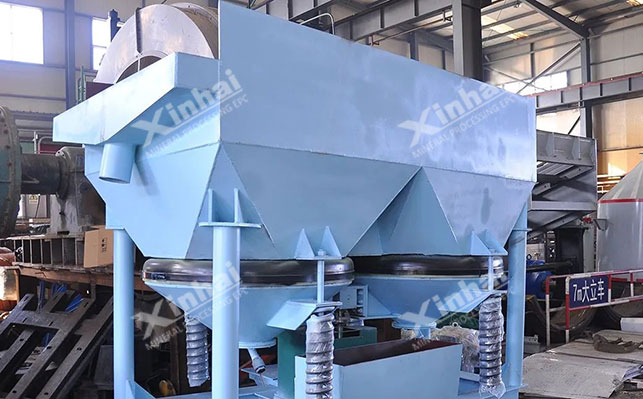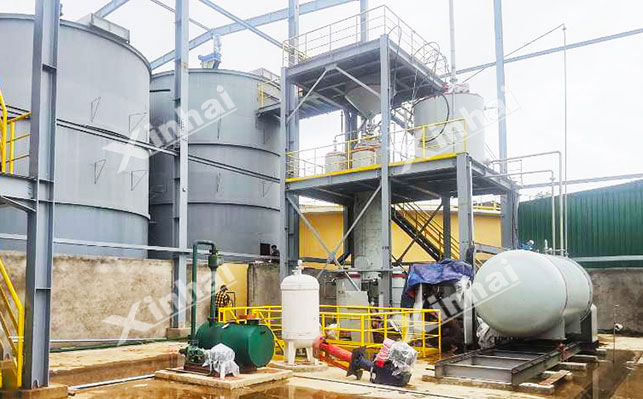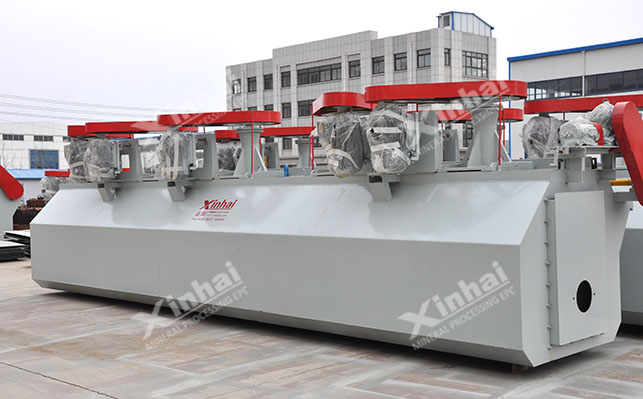
15311826613
Click to add WeChatSecondary gold ore refers to the gold ore body formed by the re-migration and enrichment of gold elements in the surface or near-surface environment of primary gold ore after long-term weathering, erosion, transportation and sedimentation. For example, during the weathering process, the minerals in the primary gold ore are decomposed, and the gold elements are released from the original minerals. Then, under the transportation of water flow, wind force, etc., the gold particles are brought to the new sedimentary environment, gradually gathered under favorable geological conditions, and finally formed secondary gold mines. So what are the methods and processes for gold extraction from secondary gold mines? Let's learn about it together!
The conventional secondary gold ore extraction methods are mainly gravity separation, amalgamation, cyanidation and flotation.

Secondary gold gravity separation is based on the large density difference between gold and other minerals. Under the action of external forces such as water flow and centrifugal force, gold particles can be effectively separated from impurities such as gangue. The density of gold is usually around 19.3g/cm³, which is much larger than the density of common gangue minerals such as quartz, which is about 2.65g/cm³.
Its gravity separation process mainly uses different gravity separation equipment, such as shaking tables, chutes, and jigs to complete gravity separation and gold extraction. Among them, the chute is where the slurry flows in from the upper end of the chute. Under the force of gravity and water flow, the gold particles gradually settle at the bottom of the chute due to their high density and fast sedimentation speed, while light minerals such as gangue are discharged from the lower end of the chute with the water flow; the shaking table gravity separation is where the slurry is on the shaking table surface. Under the combined action of asymmetric reciprocating motion and lateral water flow, the gold particles are divided according to density and particle size, and the gold particles with high density move to the concentrate end, thereby achieving enrichment; the jigging gold extraction is where the diaphragm reciprocates up and down, causing the water in the jigging chamber to produce a pulsating water flow that alternates up and down. After the slurry is fed to the jig chamber, under the action of the pulsating water flow, mineral particles of different densities and particle sizes are stratified according to density. Gold particles have high density and fast sedimentation speed, gradually gathering in the lower layer and becoming heavy products; mineral particles with low density such as gangue are distributed in the upper layer and discharged as light products, thus achieving separation.
The process of secondary gold re-selection method is relatively simple, with low equipment cost and good environmental protection. It is especially suitable for treating secondary gold mines with coarse gold particles and can quickly enrich a large amount of gold.
The secondary gold amalgam method uses the special affinity of mercury for gold. Mercury can selectively adsorb and wet the surface of gold particles, and diffuse into the interior of gold particles by its own chemical activity. The two react chemically to form amalgam alloy. This special affinity enables mercury to accurately combine with gold in many minerals, providing a feasible way to extract gold from secondary gold mines.
The process is to fully mix the gold-containing ore with mercury, and promote the contact reaction of mercury and gold to form amalgam by stirring, grinding and other methods. Subsequently, the amalgam is distilled. During the heating process, mercury has a relatively low boiling point (about 356.6°C), and is first volatilized by heat and escapes in gaseous form. Gold, however, remains solid at this temperature due to its high boiling point (about 2856°C). The volatilized mercury vapor is cooled and recovered through a condensation device.
In some small-scale gold mining operations, this method strictly controls the distillation temperature between 380-420°C, which can not only ensure the rapid volatilization of mercury, but also minimize the loss of gold and impurity residues, thereby obtaining high-purity gold products. However, mercury is toxic and has great harm to the environment and human body, and its use is now strictly restricted.

Secondary gold cyanidation is to react chemically with cyanide (such as sodium cyanide NaCN) and gold under alkaline conditions, so that gold dissolves to form a gold-cyanide complex and enters the solution, and then recovers gold through adsorption, displacement and other means.
Full mud cyanidation (carbon pulp method): suitable for secondary gold mines with good gold mineral dissociation. Mix the ground ore with cyanide solution and leach it under aeration to dissolve the gold. The gold-cyanide complex in the leachate is adsorbed by activated carbon, and then the gold-loaded carbon is desorbed and electrolyzed to obtain gold mud, and finally the gold mud is smelted to obtain high-purity gold.
Heap leaching method: for secondary gold mines with low grade and loose ore properties. The crushed ore is piled on an impermeable bottom pad, and the ore pile is sprayed with a low-concentration cyanide solution. After the gold is dissolved, it percolates into the collection pool with the solution. Then the gold is recovered from the solution by zinc powder replacement, activated carbon adsorption, etc.
Tank leaching method: suitable for treating secondary gold mines of medium scale, relatively uniform ore properties, and moderate gold mineral embedding particle size. The ore is crushed and ground into a special leaching tank, and an appropriate amount of cyanide solution and adjuster are added. After leaching, the gold-containing solution is separated from the slag by solid-liquid separation methods such as filtration or thickening. Then the gold is recovered from the solution by zinc powder replacement, activated carbon adsorption, etc.
Agitation cyanidation method: suitable for treating secondary gold ores with fine gold minerals and complex composition. In the agitation tank, the ground ore is fully mixed with the cyanide solution. At the same time, air or oxygen is introduced into the tank to promote the dissolution reaction of gold. After leaching, the gold is recovered through solid-liquid separation, solution treatment and other steps.

Secondary gold flotation is based on the difference in physical and chemical properties between the surface of gold minerals and gangue minerals. By adding flotation agents, the wettability of the mineral surface is changed. The surface of the gold mineral is hydrophobic and can attach to the bubbles, while the surface of the gangue mineral is hydrophilic and remains in the slurry, thereby achieving separation.
Generally, the secondary gold ore is first ground to a suitable particle size to dissociate the gold mineral monomer. After slurry adjustment, collectors, frothers and regulators are added. In the flotation machine, stirring and aeration are performed to make the gold mineral float up with the bubbles to form a foam layer. The foam is scraped off to obtain the gold-containing concentrate, and the tailings are discharged. This method can effectively process secondary gold ores with fine-grained intergrowth and complex symbiosis with other minerals. It can be used in combination with other methods to improve the gold recovery rate.
The above is an introduction to the beneficiation technology and process for secondary gold ores. In actual beneficiation plants, whether it is secondary gold or primary gold, the beneficiation method must be determined according to the properties of the gold ore. Therefore, it is recommended to conduct beneficiation tests and design suitable gold extraction technology and a complete set of gold extraction equipment through test analysis.